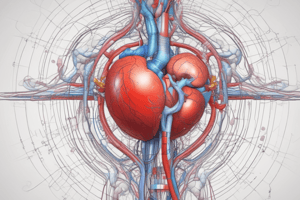Podcast
Questions and Answers
What is the main function of the carbonic acid-bicarbonate system in the body?
What is the main function of the carbonic acid-bicarbonate system in the body?
- To excrete bicarbonate ions
- To retain hydrogen ions
- To neutralize H+ ions and maintain pH balance (correct)
- To inhibit the respiratory system
How does the respiratory system compensate for changes in pH in the body?
How does the respiratory system compensate for changes in pH in the body?
- By increasing ventilation (correct)
- By increasing bicarbonate production
- By decreasing ventilation
- By decreasing pH levels
What happens in renal buffering when there is a decrease in bicarbonate levels?
What happens in renal buffering when there is a decrease in bicarbonate levels?
- Acidosis occurs
- pH increases
- Renal system shuts down
- pH decreases (correct)
Which of the following conditions is characterized by a systemic increase in H+ concentration?
Which of the following conditions is characterized by a systemic increase in H+ concentration?
What is the normal range of arterial blood pH in humans?
What is the normal range of arterial blood pH in humans?
In which type of acid-base imbalance does the pH decrease and HCO3- levels rise above 26?
In which type of acid-base imbalance does the pH decrease and HCO3- levels rise above 26?
What is the compensation mechanism for metabolic acidosis?
What is the compensation mechanism for metabolic acidosis?
Which condition is caused by high altitudes, hypermetabolic states, and early salicylate intoxication?
Which condition is caused by high altitudes, hypermetabolic states, and early salicylate intoxication?
What happens to potassium (K+) levels in the body when H+ ions move into the intracellular space during metabolic acidosis?
What happens to potassium (K+) levels in the body when H+ ions move into the intracellular space during metabolic acidosis?
Which acid-base imbalance causes hypocapnia and a decrease in pCO2 levels?
Which acid-base imbalance causes hypocapnia and a decrease in pCO2 levels?
Which ion is important in the maintenance of fluid and electrolyte balance?
Which ion is important in the maintenance of fluid and electrolyte balance?
What can cause decreased neuromuscular excitability and cardiac dysrhythmias?
What can cause decreased neuromuscular excitability and cardiac dysrhythmias?
Which condition can cause tetany, muscle spasms, and Chvostek and Trousseaus signs?
Which condition can cause tetany, muscle spasms, and Chvostek and Trousseaus signs?
What can facilitate the movement of potassium into the cells?
What can facilitate the movement of potassium into the cells?
Which electrolyte imbalance is commonly associated with hyperglycemia due to water shifts?
Which electrolyte imbalance is commonly associated with hyperglycemia due to water shifts?
What is the relationship between pH and calculus formation in urine?
What is the relationship between pH and calculus formation in urine?
Which condition is indicated by renal colic?
Which condition is indicated by renal colic?
What symptoms are associated with lower UTIs caused by kidney stones?
What symptoms are associated with lower UTIs caused by kidney stones?
What is the syndrome characterized by detrusor overactivity and weak bladder function?
What is the syndrome characterized by detrusor overactivity and weak bladder function?
Which type of renal cell carcinoma originates from the tubular epithelium in the renal cortex?
Which type of renal cell carcinoma originates from the tubular epithelium in the renal cortex?
What is the compensatory mechanism of the kidneys in respiratory alkalosis?
What is the compensatory mechanism of the kidneys in respiratory alkalosis?
Which type of nephron is the most abundant?
Which type of nephron is the most abundant?
What is the role of juxtamedullary nephrons in urine concentration?
What is the role of juxtamedullary nephrons in urine concentration?
Which cells synthesize nitric oxide and endothelin-I in the kidney?
Which cells synthesize nitric oxide and endothelin-I in the kidney?
How does an increase in sodium filtration affect the glomerular filtration rate (GFR)?
How does an increase in sodium filtration affect the glomerular filtration rate (GFR)?
What is the primary function of angiotensin II in the body?
What is the primary function of angiotensin II in the body?
Which hormone acts as a natural antagonist to the Renin-Angiotensin-Aldosterone System (RAAS)?
Which hormone acts as a natural antagonist to the Renin-Angiotensin-Aldosterone System (RAAS)?
What stimulates the release of antidiuretic hormone (ADH) in the body?
What stimulates the release of antidiuretic hormone (ADH) in the body?
Which term describes a situation where there is an increase in aldosterone secretion due to low blood volume?
Which term describes a situation where there is an increase in aldosterone secretion due to low blood volume?
What is the characteristic of hypertonic solutions in terms of osmotic pressure?
What is the characteristic of hypertonic solutions in terms of osmotic pressure?
Which manifestation is a common symptom of renal cancer?
Which manifestation is a common symptom of renal cancer?
What is the primary risk factor for bladder cancer?
What is the primary risk factor for bladder cancer?
Which condition is indicated by proteinuria and smoky brown-tinged urine?
Which condition is indicated by proteinuria and smoky brown-tinged urine?
What does oliguria indicate?
What does oliguria indicate?
Which is the common cause of intrarenal renal failure?
Which is the common cause of intrarenal renal failure?
What is the primary manifestation of pyelonephritis?
What is the primary manifestation of pyelonephritis?
What does nephrotic sediment contain in massive amounts?
What does nephrotic sediment contain in massive amounts?
What does AKI stand for in renal injury classification?
What does AKI stand for in renal injury classification?
What does the RIFLE acronym represent in diagnosing renal injury?
What does the RIFLE acronym represent in diagnosing renal injury?
What blood work changes are commonly seen in AKI?
What blood work changes are commonly seen in AKI?
Flashcards are hidden until you start studying




